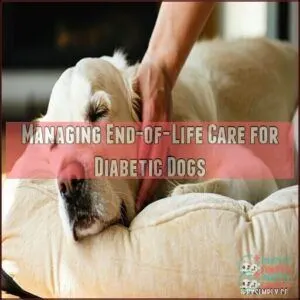This site is supported by our readers. We may earn a commission, at no cost to you, if you purchase through links.
 When your dog with diabetes is nearing the end of its life, you’ll notice signs like severe weight loss, extreme lethargy, and a lack of appetite.
When your dog with diabetes is nearing the end of its life, you’ll notice signs like severe weight loss, extreme lethargy, and a lack of appetite.
They might drink and urinate excessively or show signs of confusion and disorientation. Some dogs develop muscle tremors, seizures, or labored breathing due to diabetic complications like ketoacidosis.
You may also see changes in their personality—withdrawal, irritability, or a sudden loss of interest in favorite activities. These signs often signal declining quality of life.
Monitoring closely and consulting with your vet guarantees you make informed, compassionate choices during this difficult time. Every moment counts and it is crucial to be aware of these signs to ensure the best possible care for your dog, which can help in making informed decisions.
Table Of Contents
- Key Takeaways
- Identifying End-Stage Diabetes in Dogs
- Diabetic Ketoacidosis in Dogs
- Recognizing The Final Stages of Diabetes
- Managing End-of-Life Care for Diabetic Dogs
- Life Expectancy and Prognosis for Diabetic Dogs
- Monitoring Quality of Life in Diabetic Dogs
- Signs That Your Diabetic Dog is Suffering
- Making End-of-Life Decisions for Diabetic Dogs
- Frequently Asked Questions (FAQs)
- How do you know if a diabetic dog is dying?
- What are the early signs or symptoms of diabetes?
- What happens when a diabetic dog dies?
- What happens if a dog is diabetic?
- What is the life expectancy for a dog with diabetes?
- How do you know when it’s time to put a dog down with diabetes?
- How do you treat a 13 year old dog with diabetes?
- Do diabetic dogs sleep a lot?
- How fast can diabetes progress in dogs?
- Can diabetes in dogs go into remission?
- Conclusion
Key Takeaways
- Watch for severe weight loss, lethargy, and refusal to eat as clear signs your dog’s condition is worsening.
- Excessive thirst and urination signal poorly managed blood sugar and declining kidney function.
- Behavior changes like confusion, withdrawal, or unresponsiveness suggest cognitive decline or severe discomfort.
- Persistent pain, trouble moving, and difficulty breathing mean it’s time to consult your vet about end-of-life care.
Identifying End-Stage Diabetes in Dogs
You’ll need to recognize the critical signs that indicate your diabetic dog has entered the end stage of their illness, including severe weight loss, excessive thirst, lethargy, and recurring infections.
Understanding these warning signals can help you make informed decisions about your pet’s care and quality of life during this difficult time, and it is crucial to be aware of the critical signs.
Recognizing critical signs early ensures your dog’s comfort and guides compassionate decisions in their final moments.
Severe Weight Loss and Lack of Appetite
Watching your diabetic dog’s body rapidly shrinking despite insulin treatment can be heartbreaking.
When severe weight loss and lack of appetite signal end-stage diabetes, it’s essential to recognize these warning signs:
- Visible ribs and spine with muscle wasting, particularly in hind legs
- Dramatic calorie deficit despite normal feeding attempts
- Compromised nutrient absorption causing a hollow-faced appearance
- Sudden disinterest in previously loved treats (diabetic dog lethargy)
- Loose skin folds indicating significant weight reduction
Contact your veterinarian immediately if these changes occur, as they indicate serious metabolic changes.
You may also want to explore a dog appetite stimulant to encourage eating, which can help with diabetic dog lethargy and improve their overall condition, addressing the dramatic calorie deficit and promoting a healthier appearance by reducing muscle wasting.
Increased Thirst and Urination
While your diabetic pet may have already lost weight, excessive thirst and urination represent a critical warning sign as their condition worsens.
In end-stage diabetes, uncontrolled blood glucose levels trigger extreme thirst (polydipsia) and urination (polyuria), often leading to accidents around your home.
This dangerous cycle affects kidney function and creates electrolyte imbalances.
Despite drinking constantly, your dog faces significant dehydration risks as their bladder control diminishes—a clear indicator their condition is deteriorating rapidly.
Lethargy and Changes in Behavior
While increased thirst signals physical distress, lethargy and behavioral changes reveal how diabetes affects your dog’s very essence.
Beyond just physical symptoms, endstage diabetes manifests through sudden inactivity and profound personality shifts.
Your formerly energetic companion shows concerning dying dog symptoms through:
- Sleep pattern changes – spending 20+ hours resting instead of playing
- Social withdrawal – hiding behavior in closets or under furniture
- Confusion signs – appearing lost in familiar surroundings
- Decreased mobility – struggling with stairs they once bounded up
These changes aren’t simply "bad days" – they’re serious indicators that diabetes is progressing beyond management. Your once-vibrant friend’s unresponsiveness speaks volumes about their declining condition.
Decreased Quality of Life
Beyond lethargy comes a more profound change—your dog’s declining quality of life reflects end-stage diabetes progression.
When evaluating your pet’s well-being, watch for these critical signs:
| Quality Measure | Normal Signs | Warning Signs |
|---|---|---|
| Eating Habits | Enjoys meals | Loss of appetite |
| Mental Wellbeing | Engaged, alert | Cognitive decline |
| Mobility | Active movement | Decreased mobility |
It’s also important to be aware of common pet issues that can arise and further complicate their condition.
When good days become rare and persistent pain is evident, it’s time for compassionate discussions with your vet about your dying dog’s comfort.
Diabetic Ketoacidosis in Dogs
Diabetic ketoacidosis (DKA) is a life-threatening complication that occurs when your dog’s body, unable to use glucose properly, starts breaking down fat for energy and produces toxic acids called ketones.
You’ll notice your dog’s breath may smell sweet or like acetone, accompanied by rapid breathing, severe lethargy, vomiting, and dehydration—all signs requiring immediate emergency veterinary care.
Definition and Explanation
When your diabetic pet’s body shifts into crisis mode, diabetic ketoacidosis emerges as a life-threatening complication.
This dangerous condition occurs when insulin deficiency forces the body to burn fat instead of glucose, creating toxic acid levels in the bloodstream.
- The body produces ketones that dangerously acidify the blood
- Critical organs begin to fail as the metabolic crisis deepens
- Severe dehydration and electrolyte imbalances develop rapidly
- Without immediate veterinary intervention, coma and death can occur within days
Think of it as your dog’s body basically poisoning itself when glucose control fails completely, making hospice care or emergency treatment imperative.
Causes and Risk Factors
Now that we’ve a grasp of what diabetic ketoacidosis is, let’s examine what causes this life-threatening complication in diabetic dogs.
Understanding the causes of diabetic ketoacidosis helps you recognize when your dog might be at risk. Almost any significant stress or illness can trigger this dangerous condition in dogs with diabetes.
| Risk Factor | Examples | Impact |
|---|---|---|
| Underlying Illnesses | UTIs, pancreatitis, Cushing’s disease | Primary trigger in 70% of cases |
| Insulin Issues | Missed doses, insufficient insulin | Leads to cellular starvation |
| Physical Stressors | Surgery, infections, organ failure |
Increases counter-regulatory hormones
This knowledge is crucial because it allows dog owners to be proactive in managing their dog’s health, especially when significant stress or illness is present, which can lead to diabetic ketoacidosis.
Symptoms and Diagnosis
Now that you understand the underlying risk factors, recognizing the symptoms of diabetic ketoacidosis (DKA) is critical for your dog’s survival.
Initial symptoms include extreme thirst, excessive urination, rapid breathing, and a fruity breath odor.
Your veterinarian will perform diagnostic tests, including blood glucose measurements and urine analysis, to confirm DKA.
These tests check for elevated ketones and glucose levels, alongside signs of organ failure affecting the kidneys or liver.
A key indicator can be increased thirst and urination, which signals excess glucose excretion.
Swift veterinary examination can mean the difference between life and death for your furry companion, emphasizing the importance of prompt action and early detection to prevent organ failure and ensure your dog’s survival.
Treatment and Management
After diagnosing diabetic ketoacidosis (DKA), proper treatment becomes your lifeline for managing this serious complication.
Your veterinarian will typically implement an aggressive approach to stabilize your dog’s condition.
Treatment typically involves:
- Immediate IV fluid therapy to correct dehydration and electrolyte imbalances
- Regular insulin administration to lower blood sugar levels and stop ketone production
- Continuous glucose monitoring to adjust insulin dosing as needed
Most dogs require hospitalization for several days while undergoing intensive care.
Once stabilized, you’ll work with your vet to establish a long-term diabetic management plan involving insulin therapy, dietary control, and appropriate exercise.
Recognizing The Final Stages of Diabetes
You’ll notice distinct changes in your diabetic dog’s condition when they enter the final stages of their illness, including increased lethargy, severe weight loss despite eating, and persistent vomiting that doesn’t respond to treatment.
Recognizing these critical warning signals early allows you to make informed decisions about your pet’s care and quality of life, whether that means adjusting their treatment plan or considering more compassionate end-of-life options.
This enables you to prioritize your pet’s well-being, ensuring they receive the best possible care during their final stages, which can include managing severe weight loss.
Persistent Clinical Signs
Persistent signs of advanced diabetes can’t be overlooked.
When your dog’s thirst feels unquenchable and they’re constantly peeing, even with insulin, it’s a red flag. Add chronic infections to the mix, and their appetite may shift—eating normally yet rapidly losing weight.
Vision loss from cataracts can turn life blurry. Neuropathy signs, like trouble walking, might appear.
These endstage signs suggest their condition isn’t under control. Stay vigilant—these behaviors aren’t just quirks; they’re pleas for help.
| Symptom | Cause | Impact |
|---|---|---|
| Uncontrolled Thirst | Poor glucose regulation | Frequent dehydration |
| Chronic Infections | Weakened immune system | Reduced quality of life |
| Neuropathy Signs | Nerve damage from diabetes | Mobility challenges |
Impact on Quality of Life
Diabetes can deeply affect your dog’s quality of life, making everyday tasks harder. You might notice changes like fewer tail wags or interest in play.
Their comfort and happiness decline as struggles mount. Here are five signs their daily activities and mental wellbeing are suffering:
- Difficulty enjoying social interaction or playtime.
- Increased lethargy or lack of interest in routines.
- Persistent discomfort despite pain management.
- Decreased participation in daily activities.
- Noticeable impact on your own emotional well-being.
Keeping them comfortable can ease pet suffering and promote pet comfort. Diabetes can have a significant impact on both the dog and the owner, affecting their quality of life and overall wellbeing.
Assessing Pet Quality of Life Scale
When dealing with a diabetic dog nearing the end, a pet quality of life scale lets you objectively assess their well-being.
The scale focuses on factors like eating, mobility, and joy while considering subjective indicators, owner burden, and hospice integration.
Think of it as a roadmap for tough decisions about hospice care or euthanasia.
By tracking these components, you’ll know when palliative care is effective or if intervention impact suggests it’s time for harder choices.
Many owners seek resources to improve their dog’s overall comfort.
Consulting With a Veterinarian
Your vet’s expertise is invaluable when managing the final stages of your dog’s diabetes.
A veterinary consultation can offer clear guidance on treatment adjustments or hospice care when daily struggles start overshadowing the good moments.
They’ll honestly address options like euthanasia with compassion, helping you make decisions anchored in love and practicality.
Veterinary recommendations guarantee your pet’s comfort stays the priority, whether through in-office visits or even online veterinary services.
Trust their insights—they’re your partner in this bittersweet journey.
Managing End-of-Life Care for Diabetic Dogs
Caring for a diabetic dog in their final days is about keeping them comfortable and ensuring their needs are met.
You’ll work closely with your veterinarian to make compassionate decisions that prioritize their quality of life.
Treatment Options and Available Help
When your dog’s diabetes starts to become unmanageable, there are several ways to keep them comfortable.
With the right support, you’re not in this alone.
Consider these options to help manage their care:
- Insulin Therapy Adjustments: Work with your vet to refine dosages and improve glucose control.
- Dietary Management: Opt for specific diabetic-friendly diets to stabilize blood sugar levels.
- Glucose Monitoring Tools: Use devices like AlphaTrak2 for at-home management.
- Financial Assistance: Seek programs or nonprofits to ease the costs of care.
Your dog’s comfort comes first—small steps can make a big difference!
Euthanasia as a Humane Option
Choosing humane euthanasia for your dog isn’t giving up—it’s making an ethical decision to end their suffering.
When quality of life fades, freeing them from pain is an act of love. Evaluating their comfort, behavior, and ability to enjoy daily life helps guide you.
Work closely with your vet, who can guarantee a peaceful goodbye. It’s okay to grieve, knowing you’ve honored your dog’s journey with compassion and care.
Supporting Owners in End-of-Life Decisions
Making end-of-life decisions isn’t easy, but it’s done with love.
If you’re feeling euthanasia guilt, remember it’s about quality of life, not quantity.
Assess their comfort daily—small joys like favorite treats may fade.
Explore hospice options for extra support, but weigh financial concerns too.
Grief support groups can help ease the burden, and it’s okay to lean on loved ones.
Saying goodbye to your furry friend is heartbreaking, but also the kindest act of all.
Guidance From Veterinarians
Your veterinarian is your partner in traversing this difficult road.
They’ll offer treatment guidance, recommend symptom alleviation strategies, and suggest hospice care options to maintain your dog’s comfort.
Honest conversations about euthanasia dogs may feel heavy, but they’re vital for ethical considerations and making informed end-of-life decisions.
Trust their expertise to assess your pup’s quality of life and tailor care.
Remember, you’re not alone—veterinary guidance guarantees compassion every step.
Life Expectancy and Prognosis for Diabetic Dogs
When your dog is diagnosed with diabetes, it’s natural to wonder how long they might live and what to expect.
While factors like age, other illnesses, and proper care play a role, understanding their prognosis helps you prepare for the journey ahead.
Factors Affecting Life Expectancy
Life expectancy for diabetic dogs hinges on numerous factors.
Age at diagnosis plays a critical role, as younger dogs often adapt better to treatment.
Breed influence and genetic predisposition can affect the prognosis, with some breeds being more prone to complications.
Concurrent diseases and stress weigh heavily on outcomes, impacting overall quality of life.
Treatment adherence, including consistent insulin therapy and a balanced diet, substantially boosts longevity, offering your dog the best chance at a fulfilling life.
Age and Concurrent Medical Conditions
As dogs age, managing geriatric diabetes becomes trickier, especially with concurrent conditions like kidney or heart disease.
Older pups often face slower healing and age-related decline, influencing prognosis factors. Juggling comorbidities impacts treatment challenges, making it harder to stabilize glucose levels.
However, with consistent care and a watchful eye, you can help maintain their quality of life.
To manage their condition effectively, consider the following steps:
- Watch for extra fatigue or lethargy.
- Monitor for worsening diabetes symptoms.
- Address other illnesses promptly.
- Maintain a stable insulin schedule.
- Evaluate regular patient check-ups, which is crucial for overall health management.
Impact of Proper Treatment and Management
Proper treatment can substantially improve your dog’s lifespan while reducing diabetes complications like diabetic ketoacidosis (DKA).
With consistent insulin therapy, personalized diets, and regular blood sugar monitoring, you’ll see enhanced wellbeing and better symptom control.
These steps cut risks, minimize costs, and allow your furry friend to thrive.
Routine vet check-ups help adjust care plans, keeping their quality of life high.
Remember, managing diabetes is a team effort—a quality of life scale can guide you in making informed end-of-life decisions while offering your dog comfort and love.
Realistic Expectations for Owners
Managing a diabetic dog requires patience, planning, and a dash of resilience.
While it’s a financial commitment and a time investment, you can still share joyful moments with your pet.
Here’s what to expect:
- Lifestyle adjustments like strict meal schedules and daily insulin shots.
- Regular vet visits to confirm treatment adherence and track progress.
- Emotional ups and downs as you assess their quality of life over time.
- Difficult end-of-life decisions, including possible euthanasia or hospice care.
Cherish every moment, knowing your care brings comfort and alleviates suffering.
Monitoring Quality of Life in Diabetic Dogs
When your dog has diabetes, monitoring their quality of life helps you recognize changes that could signal advanced stages of the disease.
By keeping track of their eating, drinking, behavior, and overall comfort, you can guarantee they receive the best possible care during this challenging time.
Assessing Eating, Drinking, and Elimination Habits
Your dog’s eating, drinking, peeing, and pooping habits provide a health snapshot.
Appetite changes, like eating less or skipping meals, signal distress, while sudden appetite loss is worrisome.
Check hydration levels—excess thirst could mean poorly managed diabetes.
Urination frequency matters; accidents or excessive peeing often indicate trouble.
Keep an eye on fecal consistency—loose stools or elimination difficulties shouldn’t be ignored.
One possible cause of increased thirst is excess glucose excretion.
These habits are essential clues and deserve daily monitoring.
| Key Habit | Healthy Sign | Warning Sign | Action to Take |
|---|---|---|---|
| Appetite Changes | Normal eating | Skipping meals | Consult your vet |
| Hydration Levels | Drinking normally | Excessive thirst | Check blood sugar levels |
| Urination Frequency | Regular peeing | Frequent accidents | Rule out infections |
| Fecal Consistency | Firm stool | Loose or sticky stool | Vet evaluation suggested |
Evaluating Mental Health and Joy
When monitoring your diabetic dog’s wellbeing, watch for noticeable mood changes and shifts in mental alertness.
Are they less enthusiastic about activities they once loved? A decline in activity enjoyment or avoiding social interaction, like greeting you at the door, can signal deeper concerns.
Cognitive decline might appear as confusion or unresponsiveness. Also, notice signs of anxiety, like pacing or tail-tucking, which could mean they’re struggling to cope.
By taking the time to spot these clues, you can better support your dog’s mental and emotional health during this challenging phase.
Considering Human Family Members’ Well-being
Caring for a diabetic dog can weigh heavily on you and your family. The caregiver burden sometimes feels nonstop, especially during end-of-life decisions.
Family grief and financial strain are common, so lean on emotional support and make certain everyone, including children, understands the situation.
Here are three tips to ease the load:
- Share caregiving tasks, balancing responsibilities to avoid burnout.
- Schedule joyful moments with your pup, whether walks or cuddles.
- Reach out to hospice care dogs programs or pet loss support groups for guidance.
You’re giving your best—don’t forget self-care.
Adjusting Care and Treatment Plans
Adjusting care is like fine-tuning an instrument—it takes patience. Focus on insulin adjustments and diet modifications to keep your pup comfortable.
Swap intense play for exercise changes that match their energy, like gentle walks. Increase monitoring glucose levels and watch for managing complications.
Vet check-ins are your lifeline during this time. Here’s a quick guide:
Signs That Your Diabetic Dog is Suffering
When your diabetic dog is suffering, you’ll notice signs that their condition is becoming harder to manage, like persistent pain or difficulty moving.
Recognizing these changes early helps you provide comfort and make the best decisions for their well-being.
Persistent Pain and Discomfort
Persistent pain signals your pup may be struggling. When discomfort becomes constant, it’s time to assess their quality of life.
Be attentive to these chronic pain signs:
- Whining or snapping when touched
- Pacing or struggles to find comfort
- Heavy panting or breathing changes
- Unexpected mood shifts like irritability
Discuss pain management options with your vet, from medications to alternative therapies. Alleviating suffering guarantees your diabetic dog receives the best care during their toughest days.
Loss of Mobility and Function
Loss of mobility and function in diabetic dogs can be truly heart-wrenching to witness.
Muscle weakness, nerve damage, and joint stiffness may make everyday activities a challenge. Your dog might struggle with stairs, avoid walks, or have trouble standing up.
Mobility aids like ramps or harnesses can ease their discomfort, while gentle, intermittent movement can help combat exercise intolerance. Many owners find specialized support products helpful for their pets.
Here’s a quick reference to support them:
| Issue | Possible Cause | Helpful Aid |
|---|---|---|
| Limping | Joint Stiffness | Orthopedic bed |
| Difficulty standing | Muscle Weakness | Harness |
| Hesitation on stairs | Nerve Damage | Ramps |
| Collapsing | Diabetic Ketoacidosis | Immediate vet care |
| Fatigue after walking | Exercise Intolerance | Shorter walk times |
Focus on providing comfort and security—they rely on your patience and love during these tender moments.
Decreased Appetite and Hydration
If your diabetic dog’s appetite wanes and hydration falters, it’s a red flag things might be worsening.
Appetite changes, like rejecting their favorite treats, paired with dehydration, signal serious underlying issues. Nutritional support becomes critical when they’re losing weight rapidly or seem uninterested in meals entirely.
Dehydration effects, such as dry gums or weakness, can escalate quickly without intervention.
- Signs to watch:
- Skipping meals or showing anorexia causes without improvement.
- Vomiting, lethargy, and refusing water even when thirsty.
- Weight loss and lack of energy despite assisted feeding or fluid therapy.
Changes in Behavior and Cognitive Function
As your dog’s diabetes worsens, you may notice emotional and mental changes that feel heartbreaking.
These shifts aren’t about stubbornness—they’re signs of cognitive decline.
Confusion and disorientation are common; your pup might get lost in their own home or struggle to find their water bowl.
They might seem less responsive and distant, avoiding social interaction or forgetting once-loved routines.
Changes in sleep patterns can emerge, with pacing or restlessness in the middle of the night.
Neurological symptoms like unsteadiness or even seizures may appear, signaling deeper struggles.
Some dogs may grow anxious or clingy, while others might show irritability, snapping without warning.
Lethargy and withdrawal can also be indicators of a sick dog, as seen in this link: Lethargy and withdrawal.
To help, maintain predictable routines and add calming activities.
A quiet, structured environment is key.
Consult your vet for strategies to address these behaviors and guarantee your dog’s comfort during this challenging time.
They’re counting on your love and patience.
Making End-of-Life Decisions for Diabetic Dogs
When your diabetic dog’s health begins to decline, making end-of-life decisions can feel overwhelming but is a paramount responsibility.
Understanding your options and focusing on your pet’s comfort can help you make thoughtful, compassionate choices during this difficult time.
Weighing Treatment Options and Quality of Life
When your diabetic pup’s health declines, weighing treatment burdens against their comfort becomes key.
Focus on their comfort and joy—it’s the most loving way to honor your diabetic dog’s final chapter.
Are their good days outnumbering the bad? Quality of life assessment can guide you—your dog’s tail-wagging moments matter.
Consider hospice care options that emphasize suffering alleviation over aggressive treatment.
Financial considerations and ethical dilemmas play a role, too.
- Signs your dog may be struggling:
- Lack of joy or energy
- Persistent discomfort despite care
- Reduced appetite
- Increased reliance on comfort care
- Emotional strain on you
Considering Euthanasia as a Selfless Act
When your dog’s days seem dominated by discomfort, euthanasia can be the most humane treatment.
It’s about ending suffering with dignity, a compassionate choice rooted in love.
Use a quality of life assessment to confirm ethical considerations are met.
Here’s a quick guide:
| Factor | Observation | Action | Priority | Goal |
|---|---|---|---|---|
| Appetite | Eating or refusing food | Consult vet; adjust care | High | Maintain comfort |
| Mobility | Struggling or immobile | Evaluate options | High | Prevent pain |
| Pain Level | Persistent or worsening | Medications or euthanasia | Urgent | Suffering alleviation |
| Hydration | Drinking excessively or less | Monitor; seek advice | Moderate | Balance wellbeing |
| Owner Wellbeing | Emotional strain noted | Seek support or guidance | High | Ensure owner’s wellness |
This isn’t giving up—it’s choosing love.
Supporting Owners in Grieving and Coping
Saying goodbye to your diabetic dog is one of the hardest decisions you’ll face, and it’s okay to feel overwhelmed.
Finding ways to honor their memory can ease the grieving process while nurturing your emotional wellbeing.
Try these coping strategies:
- Lean on support networks, like friends or grief resources, to share your feelings.
- Create a memory box filled with their photos, collars, or keepsakes.
- Memorialize your pet by planting a tree or flower in their favorite spot.
- Write a letter sharing the joy they brought into your life.
Healing takes time, so be gentle with yourself, and remember that it’s a process that requires patience and self-care.
Guidance From Veterinarians and Support Groups
During tough times with your diabetic dog, maintaining open vet communication is key. Your vet can offer hospice guidance, helping you navigate end-of-life decisions with compassion and clarity.
They’ll explain ethical considerations, like when euthanasia might be the kindest choice, tailoring advice to your pet’s condition.
Lean on support networks, such as online or in-person groups, where other pet parents share experiences and offer encouragement. These communities can help you make informed decisions and feel less alone.
Don’t ignore your emotional health—grief counseling is a valuable resource when coping with hospice care dogs. Remember, making the right end-of-life decision honors your dog’s life and guarantees they’re comfortable in their final days.
Frequently Asked Questions (FAQs)
How do you know if a diabetic dog is dying?
When the spark fades and symptoms worsen—like extreme lethargy, refusal to eat, chronic vomiting, or difficulty breathing—your dog’s quality of life may be declining.
Heavy decisions may be close; consult your vet promptly, as this can be a critical moment to consult your vet.
What are the early signs or symptoms of diabetes?
Early signs of diabetes include increased thirst and frequent urination.
You may notice your dog drinking water like it’s going out of style and losing weight despite eating normally, or even having an insatiable appetite.
What happens when a diabetic dog dies?
Imagine Max, a diabetic Labrador, who’s surrounded by loved ones.
In the end, severe weakness, labored breathing, and unresponsiveness are common.
It’s peaceful, as the body shuts down naturally, signaling relief from struggle.
What happens if a dog is diabetic?
If your dog is diabetic, their body can’t properly regulate blood sugar due to low insulin.
You’ll notice increased thirst, frequent urination, and weight loss.
Managing it requires insulin shots, a strict diet, and regular monitoring, which can help control diabetic conditions.
What is the life expectancy for a dog with diabetes?
A flickering candle holds symbolism here—dogs with diabetes can live 1-2 years with diligent care.
Managing insulin, diet, and health guarantees quality years, though progressions or complications like diabetic ketoacidosis may shorten this timeline.
How do you know when it’s time to put a dog down with diabetes?
You’ll know it’s time when your dog’s quality of life declines—chronic pain, inability to eat, or enjoy anything.
Consult your vet, trust your instincts, and remember choosing peace for them is an act of love.
How do you treat a 13 year old dog with diabetes?
Treating a 13-year-old diabetic dog means managing their insulin needs with regular injections.
Providing a balanced diet designed for glucose control, ensuring daily exercise, and scheduling consistent vet checkups to monitor their overall health closely.
Do diabetic dogs sleep a lot?
It’s common for diabetic dogs to sleep more than usual due to fluctuating blood sugar levels and low energy.
Keep an eye on their activity, and consult your vet if lethargy seems excessive or concerning.
How fast can diabetes progress in dogs?
Diabetes in dogs can progress at varying speeds, depending on their condition.
Some dogs develop symptoms gradually over weeks or months, while others experience rapid declines.
Monitor for increased thirst, urination, weight loss, or lethargy carefully.
Can diabetes in dogs go into remission?
Yes, but it’s rare.
Remission sometimes happens in dogs with prompt treatment, regulated blood sugar, and no complicating conditions.
Consistent care, a healthy diet, and close monitoring improve chances, though ongoing management is usually necessary, and this is often achieved with prompt treatment.
Conclusion
They say, "Forewarned is forearmed," and recognizing the signs your dog with diabetes is dying equips you to provide the best care in their final days.
Watch for persistent weight loss, excessive thirst, lethargy, or sudden behavior changes.
These warning signals often indicate end-stage diabetes or complications like ketoacidosis.
Consult your vet to discuss humane options, including treatment adjustments or euthanasia if needed.
Ultimately, your love and attention make these tough decisions as compassionate as possible.




















